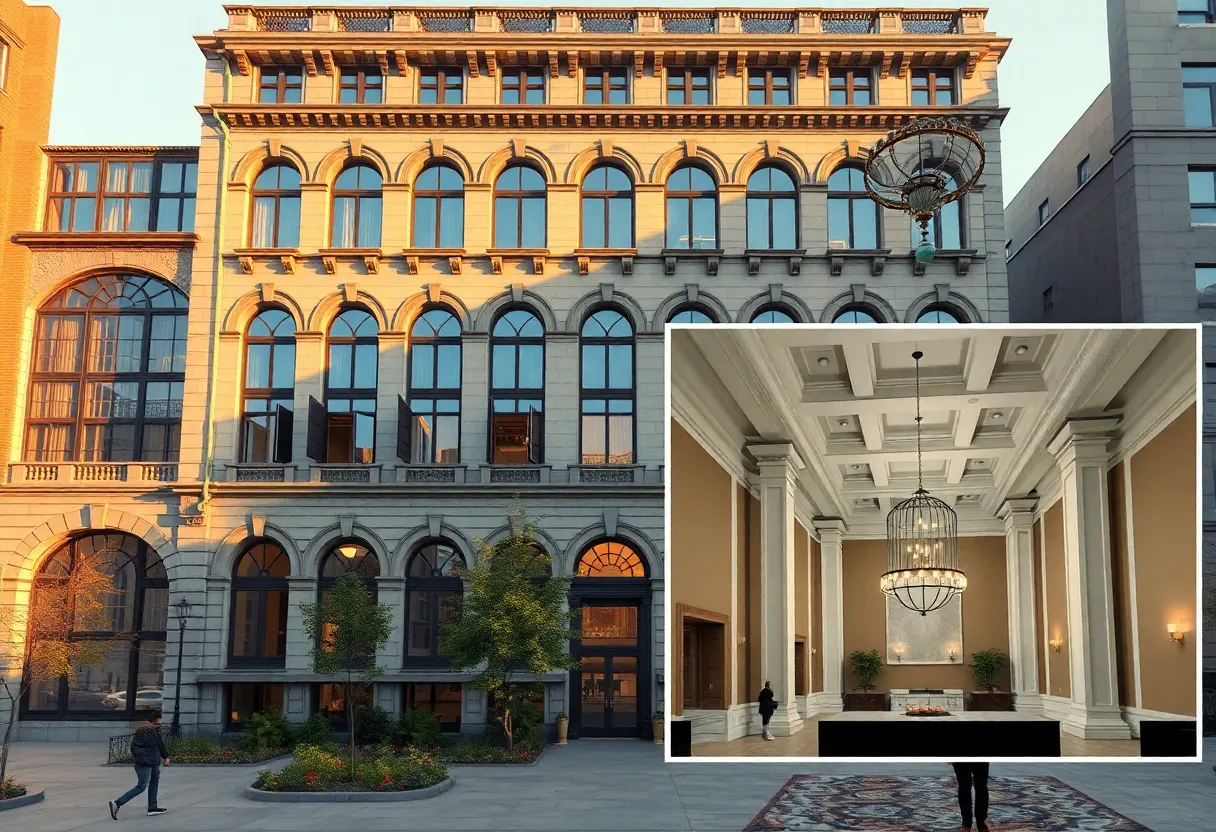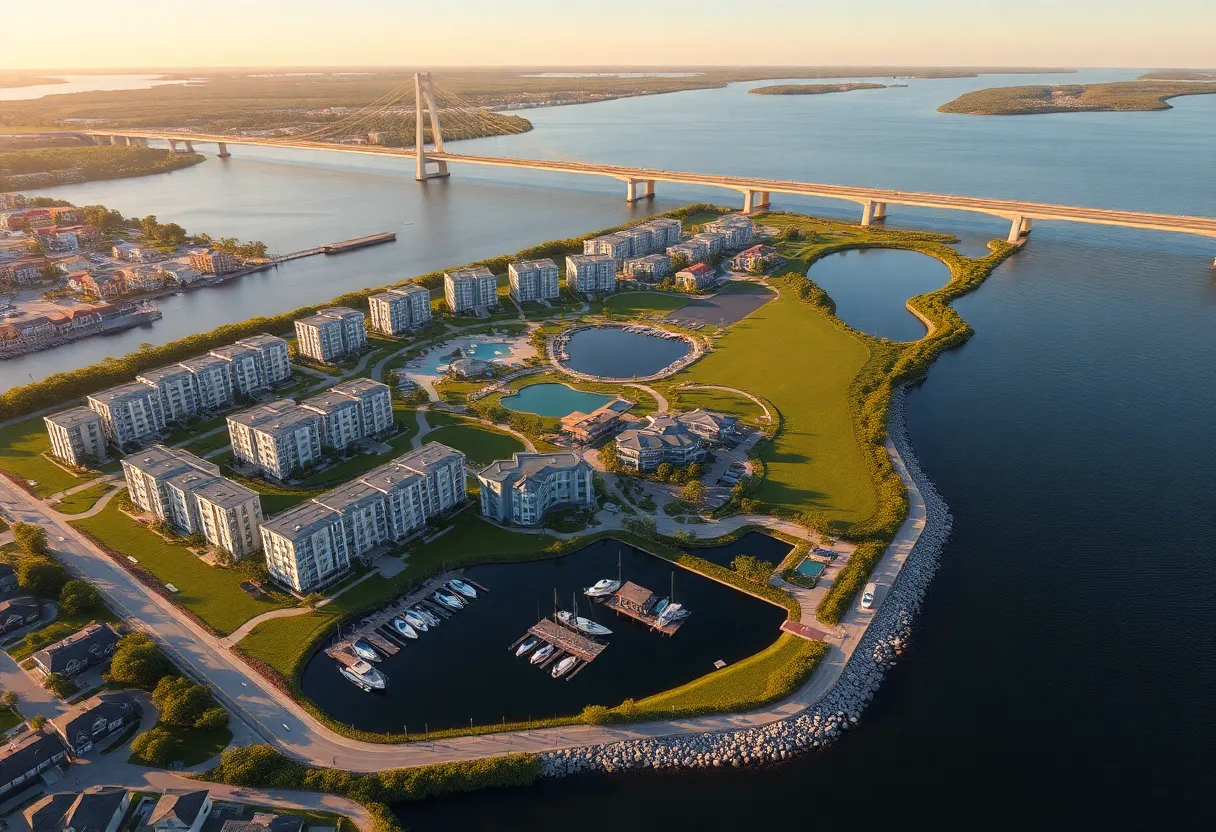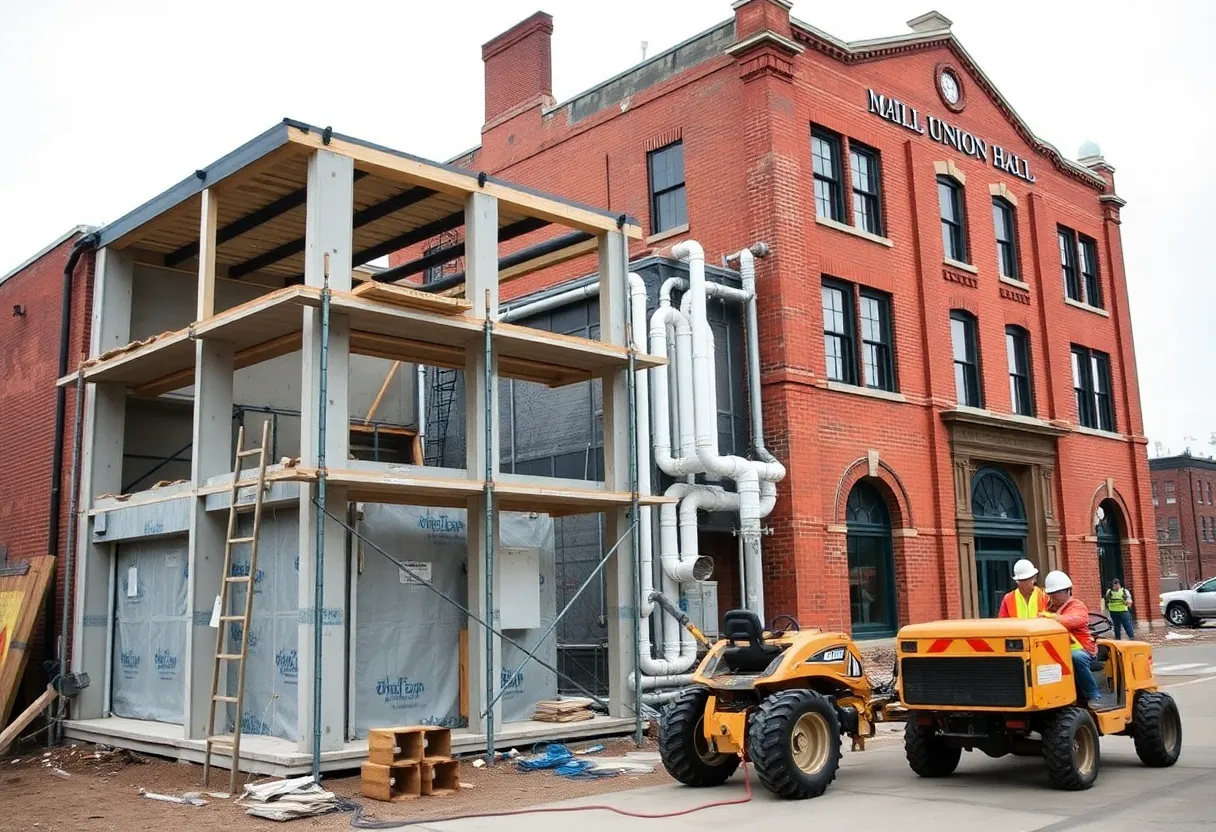Hartford, Connecticut, October 9, 2025
News Summary
Norwalk-based developer Spinnaker has opened The 55 Elm Club, a renovated century-old office complex on Hartford’s south side of Bushnell Park after a reported $67 million conversion. The two-building project preserves Renaissance Revival details—grand Doric columns, original radiators and high ceilings—while introducing roughly 127–160 modern apartments, amenities including a fitness center, co-working spaces, a speakeasy lounge, and commercial retail and restaurant areas. Leasing began in phases with the annex nearly full; about 20% of units are reserved as affordable. Financing combined construction loans, developer equity and historic tax credits, and city and state officials attended opening tours.
The 55 Elm Club opens after $67 million conversion of century-old Hartford office complex
A major downtown Hartford building on the south side of Bushnell Park has been converted into apartments and formally opened to city and state officials on a Wednesday. Norwalk-based real estate firm Spinnaker Real Estate Partners led the work, which the firm reports cost $67 million and returned a historic office complex to active residential use under the new name The 55 Elm Club.
What opened and who attended
The conversion covers a two-building complex totaling about 234,000 square feet, including a seven-story Renaissance Revival main building and a slightly younger four-story annex sometimes called The Vault. State and city leaders attended the opening and toured units and public spaces, where visitors saw ceilings up to 20 feet, an ornate foyer lined with Doric columns, and a grand, chandeliered room set aside for a future restaurant.
Units, leasing and rent
Reporting on the conversion lists varying unit counts across sources. The development is described as converting into approximately 160 apartments in some accounts, while other reports list 127 to 128 units in the main building and 32 units in the annex. Leasing began in the annex last fall and in the main building over the summer. The annex is nearly fully occupied by the developer’s account, and roughly half of the main building’s units were ready at the time of the opening.
Published listings show rents ranging across unit types. For the annex, studio and one-bedroom listings start around $1,440 and $1,620 per month, respectively. In the main building, studios start near $1,750; one-bedrooms start near $1,620; and two-bedrooms start near $2,695. Rents do not include some additional service fees that may apply.
Design features and amenities
The conversion preserved many historical touches while adding modern apartment fittings. Notable preserved elements include original ribbed radiators kept for historical value, while modern heating and cooling are delivered by wall units. Apartments include quartz countertops, stainless steel appliances, pendant kitchen lighting and a range of ceiling heights. Shared amenities include a large central Great Hall intended for a future restaurant or public gatherings, a fitness center, billiards room, a speakeasy-style lounge in the basement, two podcast rooms carved from an old vault, a dozen co-working spaces and laundry facilities (most units also have in-unit washers and dryers).
History, architecture and preservation
The main building dates to the mid-1920s, with some records showing 1925 and others 1926 for design and construction details. Its façade was originally styled to resemble an Italian palace for the insurance company that first occupied it. The conversion followed state-level historic preservation rules that added oversight and conditions connected to public funding.
Costs, delays and financing
Project leaders described the renovation as complex and full of surprises tied to the building’s long history and many past uses; unexpected structural work and additional preservation oversight increased both cost and schedule, though exact overruns were not disclosed. Financing combined public and private sources: bridge and permanent loans from a regional development authority, commercial construction loans from banks, a certified development corporation loan, deferred developer fees and equity from the developer. Reported finance pieces include a multi-million dollar construction loan from one bank, a separate loan through another bank and over $10 million in developer equity. Public backing included bridge and permanent loans and further loan approvals for the next phases near the site.
Context and next steps
Officials described the conversion as the first major project in the Bushnell South neighborhood and as a step toward reconnecting the park with downtown, the State Capitol and nearby neighborhoods. The developer has acquired adjacent parking lots for future buildings and is lining up financing and approvals for additional apartment phases expected to add dozens to nearly two hundred more units in coming years. City leaders say such projects aim to address housing shortages that limit the ability of local businesses to attract and retain workers.
FAQ
How many apartments are in the project?
Sources vary. The overall project is described as about 160 apartments in some accounts. Other reports separate 128 units in the main seven-story building and 32 units in the four-story annex, while some accounts list 127 or 128 units for the main building.
What are typical rents?
Published listings show rents starting around $1,440 for studios in the annex and about $1,750 for studios in the main building. One-bedroom and two-bedroom starting rents vary by size, with one-bedrooms often starting near $1,620 and two-bedrooms near $2,695 in the main building. Additional service fees may apply.
Who paid for the work?
The conversion used a mix of private equity, commercial construction loans, deferred developer fees and public loans from a regional development authority. Exact figures and the mix differ across reports, but public bridge and permanent loans were a notable component alongside bank financing and developer equity.
Were historic features preserved?
Yes. The project preserved architectural details such as classical columns, decorative elements and original radiators kept for historical reference. Work was subject to added oversight due to historic funding requirements.
Are more apartments planned nearby?
Yes. The developer purchased adjacent parking lots for future housing phases and is pursuing financing and approvals that could add more apartments in the coming years.
{
“@context”: “https://schema.org”,
“@type”: “FAQPage”,
“mainEntity”: [
{
“@type”: “Question”,
“name”: “How many apartments are in the project?”,
“acceptedAnswer”: {
“@type”: “Answer”,
“text”: “Sources vary. The overall project is described as about 160 apartments in some accounts. Other reports separate 128 units in the main seven-story building and 32 units in the four-story annex, while some accounts list 127 or 128 units for the main building.”
}
},
{
“@type”: “Question”,
“name”: “What are typical rents?”,
“acceptedAnswer”: {
“@type”: “Answer”,
“text”: “Published listings show rents starting around $1,440 for studios in the annex and about $1,750 for studios in the main building. One-bedroom and two-bedroom starting rents vary by size, with one-bedrooms often starting near $1,620 and two-bedrooms near $2,695 in the main building. Additional service fees may apply.”
}
},
{
“@type”: “Question”,
“name”: “Who paid for the work?”,
“acceptedAnswer”: {
“@type”: “Answer”,
“text”: “The conversion used a mix of private equity, commercial construction loans, deferred developer fees and public loans from a regional development authority. Exact figures and the mix differ across reports, but public bridge and permanent loans were a notable component alongside bank financing and developer equity.”
}
},
{
“@type”: “Question”,
“name”: “Were historic features preserved?”,
“acceptedAnswer”: {
“@type”: “Answer”,
“text”: “Yes. The project preserved architectural details such as classical columns, decorative elements and original radiators kept for historical reference. Work was subject to added oversight due to historic funding requirements.”
}
},
{
“@type”: “Question”,
“name”: “Are more apartments planned nearby?”,
“acceptedAnswer”: {
“@type”: “Answer”,
“text”: “Yes. The developer purchased adjacent parking lots for future housing phases and is pursuing financing and approvals that could add more apartments in the coming years.”
}
}
]
}
Key features at a glance
| Feature | Details |
|---|---|
| Project name | The 55 Elm Club |
| Location | South side of Bushnell Park, downtown Hartford |
| Size | About 234,000 square feet across two buildings |
| Building types | Seven-story Renaissance Revival main building; four-story annex (The Vault) |
| Reported cost | $67 million |
| Units | Reported between 127–160 units depending on source; annex listed with 32 units |
| Rents (starting) | Studios from about $1,440–$1,750; one-bedrooms from about $1,620; two-bedrooms from about $2,695 |
| Amenities | Great Hall for future restaurant, co-working spaces, fitness center, billiards room, podcast rooms, lounge, courtyard and retail space |
| Financing highlights | Mix of public loans, bridge and permanent loans, bank construction loans, other loans and developer equity |
| Historic notes | Mid-1920s design, classical details preserved, oversight tied to historic funding |
Deeper Dive: News & Info About This Topic
Additional Resources
- FOX61: Hartford welcomes new housing — The 55 Elm Club
- Wikipedia: Hartford, Connecticut
- Hartford Courant: CT $67M project was a long and winding road
- Google Search: 55 Elm St Hartford 55 Elm Club conversion
- Hartford Business Journal: Spinnaker nears finish of $67M office-to-housing conversion
- Google Scholar: adaptive reuse office to residential Hartford
- CT Insider: Connecticut commercial apartment conversions
- Encyclopedia Britannica: historic preservation adaptive reuse
- Hartford Business Journal: Leasing underway at Bushnell South development
- Google News: Bushnell South Hartford apartments
Author: Construction NY News
NEW YORK STAFF WRITER The NEW YORK STAFF WRITER represents the experienced team at constructionnynews.com, your go-to source for actionable local news and information in New York and beyond. Specializing in "news you can use," we cover essential topics like product reviews for personal and business needs, local business directories, politics, real estate trends, neighborhood insights, and state news affecting the area—with deep expertise drawn from years of dedicated reporting and strong community input, including local press releases and business updates. We deliver top reporting on high-value events such as the New York Build Expo, infrastructure breakthroughs, and cutting-edge construction technology showcases. Our coverage extends to key organizations like the Associated General Contractors of New York State and the Building Trades Employers' Association, plus leading businesses in construction and real estate that power the local economy such as Turner Construction Company and CMiC Global. As part of the broader network, including constructioncanews.com, constructiontxnews.com, and constructionflnews.com, we provide comprehensive, credible insights into the dynamic construction landscape across multiple states.





